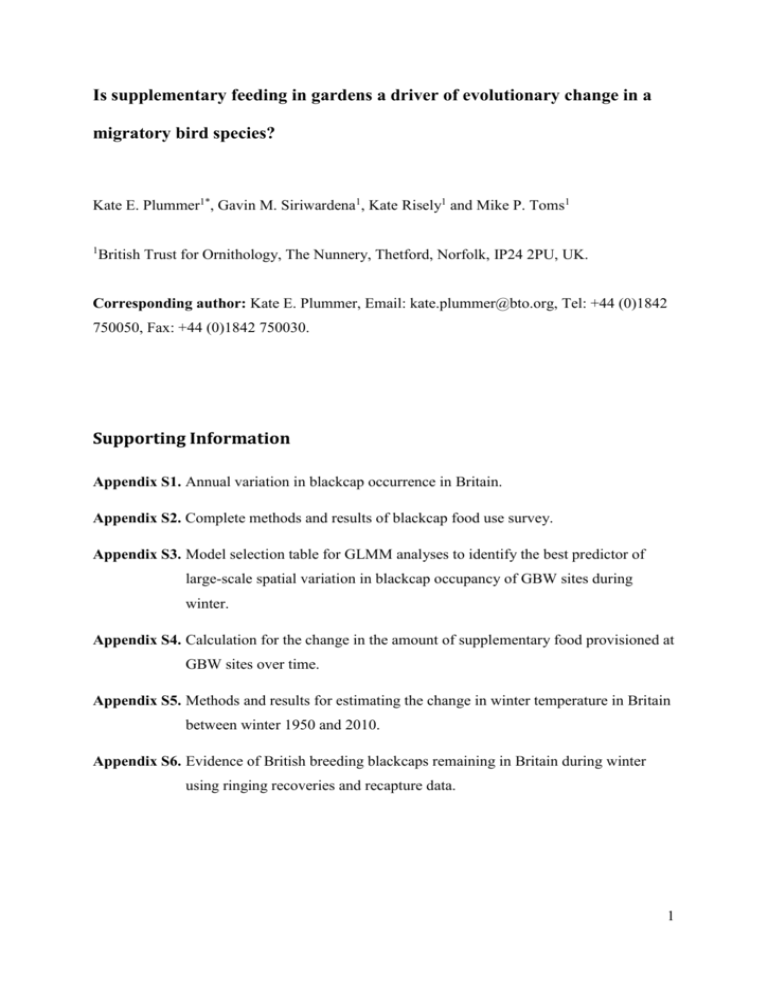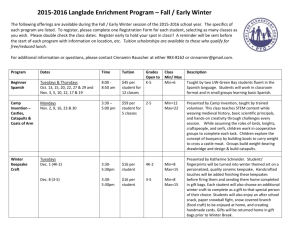gcb13070-sup-0001-AppendixS1-S6
advertisement

Is supplementary feeding in gardens a driver of evolutionary change in a migratory bird species? Kate E. Plummer1*, Gavin M. Siriwardena1, Kate Risely1 and Mike P. Toms1 1 British Trust for Ornithology, The Nunnery, Thetford, Norfolk, IP24 2PU, UK. Corresponding author: Kate E. Plummer, Email: kate.plummer@bto.org, Tel: +44 (0)1842 750050, Fax: +44 (0)1842 750030. Supporting Information Appendix S1. Annual variation in blackcap occurrence in Britain. Appendix S2. Complete methods and results of blackcap food use survey. Appendix S3. Model selection table for GLMM analyses to identify the best predictor of large-scale spatial variation in blackcap occupancy of GBW sites during winter. Appendix S4. Calculation for the change in the amount of supplementary food provisioned at GBW sites over time. Appendix S5. Methods and results for estimating the change in winter temperature in Britain between winter 1950 and 2010. Appendix S6. Evidence of British breeding blackcaps remaining in Britain during winter using ringing recoveries and recapture data. 1 Appendix S1 Annual variation in blackcap occurrence in Britain Variation in blackcap (Sylvia atricapilla) reporting rates across the annual cycle was evaluated to determine the appropriate winter timeframe for analysis, in order to avoid the inclusion of summer migrants. Weekly records of blackcap presence/absence from the British Trust for Ornithology (BTO) Garden BirdWatch (GBW) were averaged for years 1999 to 2011, using data from 3,806 sites throughout Britain selected for analysis (n = 2,201,509). On average wintering blackcaps arrived into GBW gardens from early November, with occurrence peaking between lateJanuary and early March and then declining again through late March and April (Fig. S1a). Blackcaps were recorded much less frequently in gardens between April and October. However, data from the BirdTrack scheme (www.birdtrack.net, established in 2005), where volunteers submit complete lists of all species seen and heard for a given birdwatching event, can be used to assess annual variation in the presence of blackcaps within Britain beyond only gardens. The proportions of complete lists submitted each week containing blackcap were averaged for years 2005 to 2011 (n = 433,720). On average the earliest summer migrants arrived in late March, with occurrence increasing rapidly through April and peaking at the beginning of May then declining in the autumn (Fig. S1b). Given this evidence, winter was defined as a 21-week period encompassing months November to March. This captures the full extent of the usage of gardens by blackcaps in winter during the years under investigation, but limits the possibility of including summer migrants which largely arrive in Britain during April and utilise the wider countryside. 2 Figure S1. Weekly reporting rates of blackcaps in Britain using two contrasting data sources. (a) The smoothed annual trend in the proportion of GBW gardens in Britain (n = 3806) where blackcap(s) occurred in 1999 – 2011 (± 95% CI). (b) The smoothed annual trend in the proportion of BirdTrack complete lists per week where blackcap(s) occurred in 2005 – 2011 (± 95% CI). Dotted lines represent the beginning and end of the winter period identified for analysis. 3 Appendix S2 Identification of key supplementary feeding resources for blackcaps As part of the GBW weekly recording form, surveyors submit presence-absence data for the types of supplementary foods they have provisioned each week. Supplementary food is categorised into 11 all-encompassing food types (see Fig. S2). We conducted an independent survey to identify key artificial feeding resources utilised by blackcaps. The survey was targeted at GBW participants (n = 900) who observed blackcaps in the most recent winter (2013/14) and provided at least six food types during the weeks in which blackcaps were recorded. Responses were collected using an online survey tool (SurveyMonkey, www.surveymonkey.com) from 2 May – 2 June 2014. Respondents were asked to identify which food types had been provisioned during November 2013 – March 2014, and whether or not blackcaps had been seen feeding on them. From 534 responses, blackcaps were most often seen feeding on fats (64.3% of sites where food type was fed) or sunflower hearts (50.4%) (Fig. S2). As such these foods were defined as key food resources for blackcaps, and their influence on blackcap occupancy was further investigated. Figure S2. Blackcap supplementary food preferences. Numbers correspond to the total number of respondents provisioning each food type, and percentages represent the proportions of those which observed blackcaps using the food. All food types recorded in Garden BirdWatch are reported. 4 Appendix S3 Table S3 | Model selection table for GLMM analyses to identify the best predictor of largescale spatial variation in blackcap occupancy of GBW sites during winter. Spatial predictors tested comprised REGION, latitude (LAT), longitude (LONG) and average regional temperature (TEMP). Nonlinear relationships for continuous predictors were also tested by fitting models that included quadratic terms. AIC k AIC ∆AIC weight R2GLMM(m) R2GLMM(c) 12 20706 0.0 > 0.99 0.111 0.465 6 20739 33.2 0.00 0.105 0.467 LAT + LONG 4 20815 109.3 0.00 0.081 0.464 LAT + LONG + LAT:LONG 5 20817 111.1 0.00 0.081 0.464 4 21007 301.2 0.00 0.045 0.475 LONG + LONG2 4 21021 315.3 0.00 0.045 0.474 2 TEMP + TEMP 4 21030 324.8 0.00 0.039 0.474 LAT 3 21054 348.2 0.00 0.030 0.474 TEMP 3 21058 352.1 0.00 0.031 0.475 LONG 3 21071 365.7 0.00 0.028 0.473 null 2 21184 478.6 0.00 0.000 0.478 Fixed variables REGION 2 LAT + LONG + LAT LAT + LAT 2 2 + LONG 5 Appendix S4 Estimating changes in bird feeding practices among GBW participants Assumptions regarding weekly amounts of bird food provisioning by GBW participants: A commercially bought fat ball is estimated to weigh 100g An average seed feeder has an estimated capacity of 500g As a conservative estimate of bird feeding habits and food consumption rates, an average homeowner is assumed to provision two fat balls per week and/or 250g of seed per week. Table S4 | Estimated change in total amounts of sunflower hearts and fat products provisioned during winter at analysed BTO Garden BirdWatch sites from 1999 to 2010. Average number of weeks foods were provisioned Average mass of food provisioned per garden (kg) # GBW sites Sunflower Fats Sunflower +/or Fats Sunflower Fats Total food mass in GBW sites (tonnes) 1999 2407 4.08 8.09 10.08 1.02 1.62 6.35 2000 2916 5.00 9.12 11.35 1.25 1.82 8.96 2001 3273 5.92 9.54 12.19 1.48 1.91 11.09 2002 3644 6.75 10.27 13.12 1.69 2.05 13.63 2003 3659 7.35 10.98 13.91 1.84 2.20 14.76 2004 3691 7.95 11.40 14.40 1.99 2.28 15.75 2005 3663 8.79 12.14 15.14 2.20 2.43 16.94 2006 3604 9.20 11.39 14.83 2.30 2.28 16.50 2007 3646 9.58 12.20 15.44 2.40 2.44 17.63 2008 3534 9.70 13.05 15.83 2.43 2.61 17.79 2009 3377 9.86 13.71 16.28 2.47 2.74 17.58 2010 3126 10.41 14.60 16.85 2.60 2.92 17.26 Winter 6 Appendix S5 Estimating the change in winter temperature in Britain between 1950 and 2010 Annual mean winter temperature for Britain was calculated using the average of TEMP (see Table 1) for all 5-km squares in Great Britain in each winter. Change in winter temperature over the period in which the British wintering blackcap population has become established (since the 1950s) was quantified using a linear regression of national winter temperature against winter year. British Met Office UK Climate Projections (UKCP09) gridded data is available up to the winter of 2010. In the 60 years over which the blackcap wintering population has become established in Great Britain, mean winter temperature has increased steadily from an estimated 3.70oC in 1950 to 4.90oC in 2010 (0.02oC yr -1, F1, 59 = 12.18, p < 0.001; Fig. S5). Figure S5. The trend in British winter temperature from 1950 to 2010. The line shows predicted values from the linear model. 7 Appendix S6 Evidence of British breeding blackcaps remaining in Britain during winter Blackcaps breeding in Britain predominantly migrate to southern Spain and northwest Africa for the winter months, with some perhaps crossing the Sahara (Mason, 1995, Wernham et al., 2002). Prior to 1998, only a single blackcap confirmed as a British breeder was reported to have remained in Britain during winter, while there was growing evidence that increasing numbers of wintering birds reflected a change in the migratory behaviour of the central European population (Wernham et al., 2002). It is still possible, however, that increased sedentary behaviour among British breeders has occurred. Using the same definitions of the summer and winter seasons as those used for The Migration Atlas (Wernham et al., 2002), we have evaluated recent evidence of sedentary behaviour (i.e. wintering in Britain) of breeding blackcaps using recoveries of dead birds ringed under the British Trust for Ornithology (BTO) Ringing Scheme (Table S6). Summer is defined as 1 June – 15 August and winter is defined as 1 December – 14 February. As such, the data are restricted to periods where movements are at a minimum (Wernham et al., 2002). Furthermore, we have examined evidence of individual blackcaps being ringed and recaptured in Britain in summer and winter, or vice versa (Table S6). To investigate changes in the distance of British breeders are migrating, we used linear regression to test the trend in migration distance over time using all recoveries of dead birds that had been ringed in summer and recovered in winter, or vice versa, since 1950 (n = 76). Annual totals of blackcaps ringed in Britain increased, although not always smoothly, both before and after 1998 (Robinson & Clark, 2014). Therefore, this increased ringing effort is likely to result in a greater number of summer-ringed birds being found in Britain during winter over time, by chance. However, there is no evidence that this has occurred to date, with just one further winter recovery since the previous analysis by Wernham et al. (2002) was completed (Table S6). Recaptures of live birds between summer and winter nominally provide an additional source of evidence of movements, although also influenced by variation in catching effort. There have been four such recaptures, all since 2001 (Table S6). Note, however, that all these recaptures were made at the site of ringing and that such zero-distance movements were not recorded in the ringing database before 2000. Hence, it is unknown whether a similar rate of apparent sedentary behaviour also occurred in earlier years. British 8 blackcaps have mostly been recorded wintering in Morocco, Spain, Algeria and Portugal. There is no evidence that the distance British breeders are migrating has changed over time (F1,74 = 0.13, p = 0.718). It is likely that the probability of ringing recoveries being reported is considerably lower in southern Europe and northern Africa than it is in Britain, but there is no reason to suspect that this spatial bias has changed over time, so a reduction in migratory distance ought still to be apparent if it had occurred. Overall, it remains possible that British breeding blackcaps are becoming more sedentary, but there is no evidence that any such change has involved large numbers of individuals, or a large proportion of the winter population, to date. Furthermore, there is no clear evidence that British breeding blackcaps have shortened their migration distance over time, which might have suggested the process leading to sedentary behaviour was underway (Pulido, 2007). Winter records of otherwise migratory species are a regular occurrence, so while they may show some flexibility in behaviour, they do not necessarily indicate developing changes at the population level. Table S6 | Evidence of British breeding blackcaps remaining in Britain during winter using ringing recoveries and recapture data. Data are presented for individuals ringed in Britain during either the core breeding or wintering periods (see text for definitions) and later recovered or recaptured in a different season (winter or summer respectively). Note that all recaptures reported were at the same sites at which the birds involved had been ringed originally. Ringing Date Recovery Age Sex Region Date Region Ringed in summer and recovered in winter * 02 Aug 1990 09 Jun 1997 Juvenile F East Midlands 11 Feb 1996 South East Fully-grown M East of England 27 Dec 1997 South East Recaptured in a different season 19 Jun 1999 Juvenile M East of England 29 Jan 2001 East of England 23 Jun 2001 Juvenile M South West 26 Dec 2001 South West 09 Aug 2011 Juvenile - South West 30 Jan 2012 South West 30 Jan 2012 Fully-grown F South East 26 Jul 2012 South East * Previously reported in The Migration Atlas(Wernham et al., 2002). 9 References Mason CF (1995) The Blackcap, London, Hamlyn. Pulido F (2007) The genetics and evolution of avian migration. BioScience, 57, 165-174. Robinson RA, Clark JA (2014) The Online Ringing Report: Bird ringing in Britain & Ireland in 2013 (http://www.bto.org/ringing-report, created on 30-May-2014). Thetford, BTO. Wernham CV, Toms MP, Marchant JH, Clark JA, Siriwardena GM, Baillie SR (2002) The Migration Atlas: Movements of the Birds of Britain and Ireland, London, T. & A.D. Poyser. 10






